As an Amazon Associate, we earn from qualifying purchases with no additional costs for you.
Whetstones are one of the most efficient and accurate methods of maintaining or repairing the sharp edge on your knives. Whetstones themselves require care and maintenance to keep them performing optimally and extend their longevity. We have some expert tips on caring for and maintaining your whetstones.
Whetstones last a long time if they are maintained correctly and given the correct care. Neglect can shorten the life of whetstones and, in some cases, ruin the stone. Using the right lubricant and following the correct cleaning methods for your stone is the best way to ensure long service.
Whetstones can be an expensive tool to maintain your knives, making it in your interest to take care of these stones to ensure you get maximum use, efficiency, and value from your investment. Neglecting the upkeep of your whetstones will reduce their effectiveness but could also, in some cases, ruin the whetstone. Follow our care tips to ensure this does not happen to your whetstones!
If you are interested in checking out the best whetstones for your knives we recommend and use you can find them by clicking here (Amazon link).

How To Care For A Sharpening Stone (Whetstone)?
Sharpening stones or whetstones can be made from various materials, influencing the best way to care for the stones.
The main types of whetstones include the following.
- Diamond stones
- Waterstones
- Oilstones
- Glass or ceramic stones
We will give some top tips for caring for each whetstone type to help you get the best out of your sharpening tools.
How To Care For Diamond Sharpening Stones
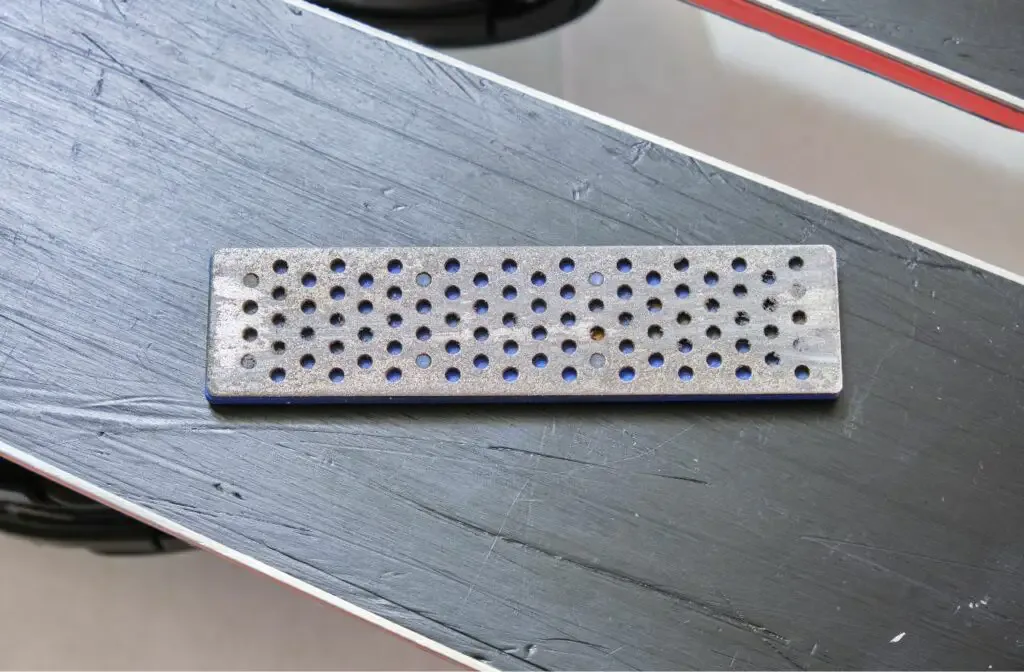
Diamond stones come in various formats and require very little care to keep them working well. The two most common diamond stone formats are a solid metal base, usually made from aluminum, with a solid surface impregnated with diamond fragments providing the abrasive.
These solid surface diamond stones are shaped to be similar sizes to traditional whetstones to fit in the same mounting blocks for ease of sharpening.
The second common diamond stone type is usually smaller, with the aim of being portable. These whetstones usually have a lightweight, hard plastic backing overlaid with a thin metal plate in which the diamond abrasives are embedded.
This type of diamond stone is usually not a solid surface but has holes cut into the top surface plate to promote sharpening waste or swarf draining from the top plate to keep the abrasive cutting effective.
Both these types of diamond stones do not require much maintenance and do not need flattening to keep them operating well. However, some maintenance is required.
Tip 1 To Maintain Diamond Stones: Clean Your Knife
Make sure the knife you need to sharpen is clean and free from any substance, particularly sticky material, that could clog up the diamond abrasive.
Sharpening a dirty knife on diamond stones can transfer the dirt to the abrasive, limiting the abrasive cutting ability. If the dirt is particularly sticky, it may be difficult or impossible to remove from the stone’s surface.
Tip 2 To Maintain Diamond Stones: Clean After Each Use
Clean your diamond stones after each sharpening session. This will prevent a buildup of sharpening waste on the stone and ensure the diamond stone is ready for the next time you need to sharpen your knife.
Cleaning will also prevent steel particles left on the surface from oxidizing and creating rust, which can damage or clog the surface plate of the diamond stone.
Tip 3 To Maintain Your Diamond Stones: Store Clean and Dry
Before storing your diamond stones, ensure they are clean and dry. Storing the stones wet will attract dust and debris to the stone’s surface and encourage oxidation of the metal surface plate.
TIP: If you are interested in more details about diamond stone maintenance, visit the complete guide in the article below:
Diamond Sharpening Stone: Explanation, Cleaning & Storage
How To Care For Water Sharpening Stones
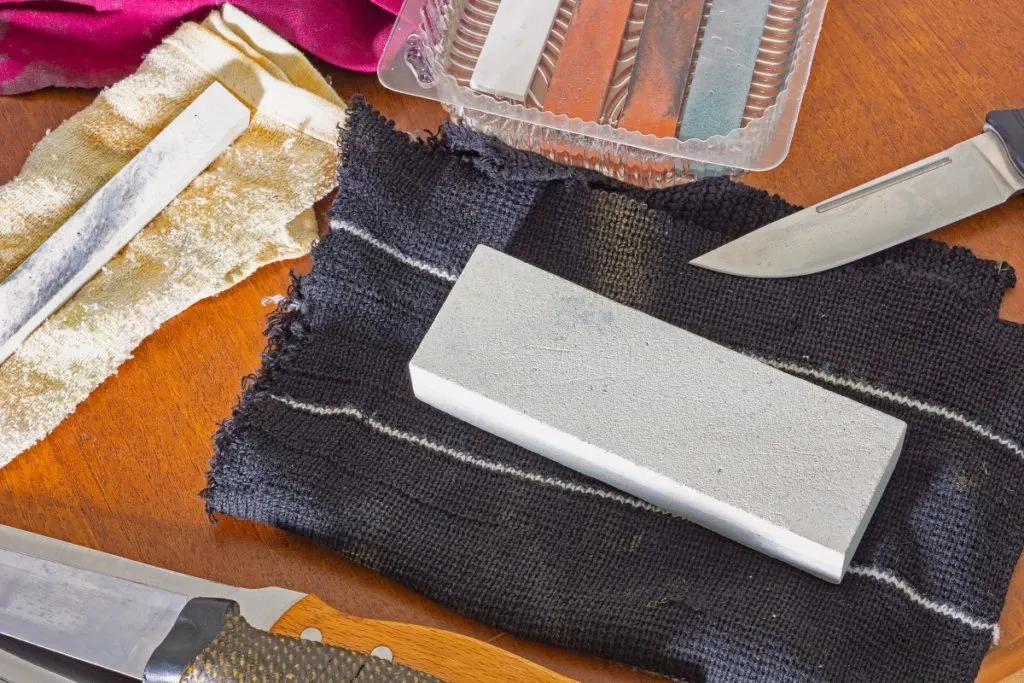
Waterstones are generally made from a natural rock material or from synthetic abrasive material. They are designed to work using water as a lubricant during the sharpening process.
Tip 4 To Maintain Waterstones: Never Use Dry
Water stones should never be used without water to lubricate the sharpening surface. Using the stones dry will cause excessive wear of the stone, effectively shortening its useful life.
The cutting ability of the dry stone will also be diminished, producing a less-than-satisfactory edge on your knife.
Tip 5 To Maintain Your Waterstone: Flip The Stone Periodically
Using the stone in the same orientation will cause the stone to wear unevenly, requiring more frequent flattening, which reduces the life of the stone.
During your sharpening process, periodically turn the stone around to use it from the opposite end.
Tip 6 To Maintain Your Waterstone: Don’t Store The Stone Wet
Waterstones should be allowed to dry before storage. This is to prevent the development of mold in the stones over time.
If you store Waterstones wet and the water in the stones freeze overnight, the expanding ice can crack your Waterstones in half.
TIP: Some of these whetstones are sometimes referred to as water stones. Can you leave these sharpening stones in the water? Find out the answer in the article below:
Can You Leave A Whetstone In Water? All You Need To Know
How To Care for Oil Sharpening Stones
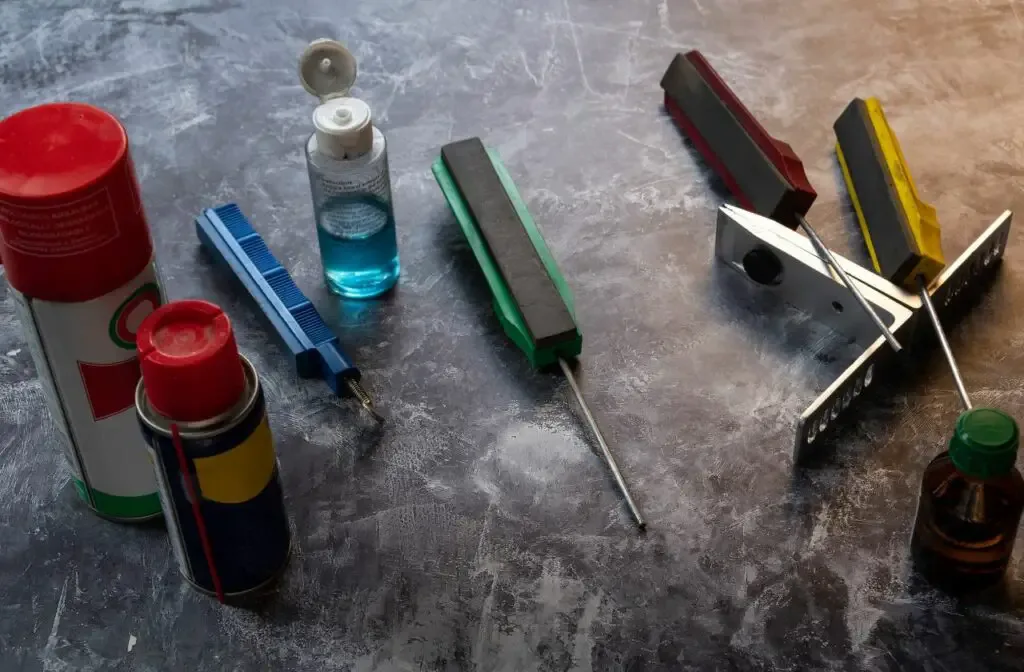
Oil stones are made from very similar materials to Waterstones. The difference is the structure of the stones is more conducive to using oil rather than water as a lubricant.
With some modern whetstones, you can decide whether you prefer using water or oil as the sharpening lubricant, but once you make a choice, you need to stick with the same lubricant for the life of the stone.
Tip 7 To Maintain Your Oil Whetstone: Use The Right Oil
All oil types are not suitable for use with an oil sharpening stone. Some oils can ruin the stone completely and reduce the effective life of the stone.
You should never use vegetable oils on sharpening stones. These oils penetrate the porous structure of the stone and become rancid in the stone. Vegetable oils also degrade and become hard and sticky over time, which is not good for a sharpening stone.
The best oil to use is an oil formulated for the task— an example of this is the Norton Food-Grade Mineral Oil (Amazon link) for sharpening stones.
Tip 8 To Maintain Your Oil Whetstone: Keep The Stone Clean
If oil is used as a lubricant on the stone, it requires frequent cleaning to prevent the stone from becoming clogged and reducing its cutting ability.
Oil is more viscous than water and holds dirt and particles more tightly than water. This means that oil is not as effective in removing debris from the stone as water.
A thorough cleaning of your oil stones every fourth or fifth use is a good maintenance regime to implement to keep your sharpening stones in good condition.
TIP: The topic of sharpening stones is already a fairly confusing topic, especially where newcomers to the knife sharpening game are concerned. Check out the differences between oil stone and water stone in the article below:
Oil Stone Vs. Water Stone: What’s The Difference?
How To Care For Glass Or Ceramic Sharpening Stones
Ceramic knife sharpeners are made from the same material used to make ceramic knives: zirconium dioxide. This material is extremely hard and durable, but as with any sharpening stone, ceramic sharpening stones require maintenance to keep them functioning well.
Tip 9 To Maintain Your Ceramic Sharpening Stone: Lubricate With Water
Ceramic stones can be used dry, but lubricating the stone with water will limit the amount of metal fragments becoming embedded on the sharpening surface.
The water used on the ceramic stone will lift the swarf from the surface and carry it away, keeping the stone operating at optimum cutting ability.
Tip 10 To Maintain Your Ceramic Sharpening Stone: Flatten The Stone
Not many people know that ceramic stones can become dished with use in the same way as Waterstones or oil stones.
It is recommended that ceramic stones be flattened before every sharpening session. Flattening is done with a specialized diamond stone made for this purpose. Flattening the stones before each sharpening session takes less than a minute.
TIP: Whetstones can be an expensive investment for people starting out learning this sharpening technique, which tempts them to buy cheap whetstones. Check out the main reasons why buying expensive whetstones is a better option in the article below:
5 Reasons Why Expensive Whetstone Is Better Than Cheap One
How To Clean Your Sharpening Stone (Whetstone)?
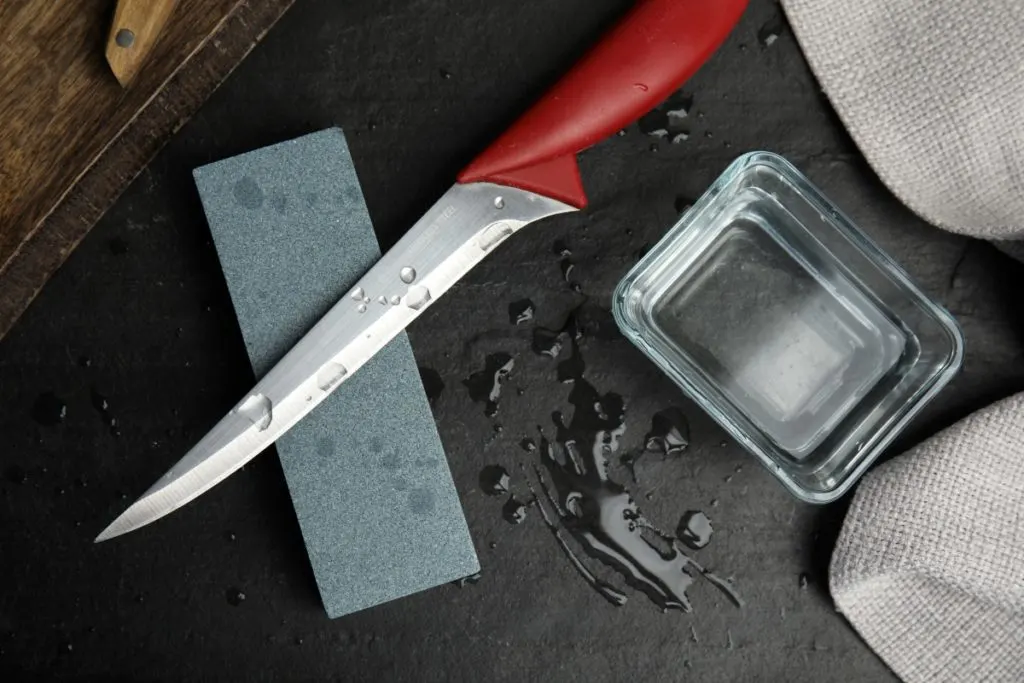
Cleaning is an important part of whetstone maintenance. The method you use to clean the stones will depend on what type of whetstone you have.
We have some tips for cleaning each whetstone type to assist you with this part of the maintenance of your sharpening stones.
How To Clean Your Diamond Whetstones
Cleaning diamond stones is an easy undertaking that should be done after every use of the diamond stone.
Tip 11: To Clean Your Diamond Whetstone: Rinse With Warm Water
Rinse the diamond stone under warm running water to remove the sharpening waste material from the stone’s surface.
Dry the stone off thoroughly before storage to prevent water from oxidizing metal particles on the diamond plate surface.
Tip 12: To Clean Your Diamond Whetstone: Scrub Periodically With A Nylon Brush
After 4 or 5 uses of your diamond stone, it can benefit from a deep clean to scrub stubborn particles from the surface plate.
Pour some warm water on the stone’s surface and gently scrub the surface with a nylon brush, such as an old toothbrush. Use a circular motion with the brush to dislodge all the dirt.
Rinse the stone off under warm running water, dry it thoroughly, and store it till you need to sharpen your knives again.
TIP: Diamond sharpening stones can be an expensive investment for your knife sharpening, but our diamond stone buyers guide will help you choose the right stones at the right price:
Buyer’s Guide: Best Diamond Knife Sharpening Stones Set
How To Clean Waterstones
Waterstones are easy to clean by simply rinsing them under running water after sharpening. This is usually sufficient to wash away any residual swarf on the stone’s surface.
Tip 13 To Clean Waterstones: Wipe The Stones With A Cloth
While you are in the process of sharpening with the Waterstone and you notice a buildup of waste material on the surface of the stone, wipe it off with a soft cloth and re-apply clean water to the stone.
This keeps the stone cleaner during the sharpening process and limits the cleaning required at the end of the sharpening session.
How To Clean Oil Stones
Oil stones can become clogged with a buildup of swarf and oil in the upper layers of the stone. The best way to clean the stones is to use some mineral spirits to dissolve the oil and loosen the accumulated dirt on the stone’s surface.
Spread some mineral spirit across the surface of the stone and give it a minute or two to dissolve the oil. Wipe the mineral spirits off the stone using a clean, soft cloth. Rub some fresh honing oils or mineral oil over the top of the cleaned stone and store the stone until needed.
Tip 14 To Clean Oilstones: Use A Credit Card To Clean Off Thick Dirt
If the oil stone has not been cleaned in some time, it may have accumulated a thick layer of waste material on the surface. After using mineral spirits to loosen the dirt, scrape an old credit card over the surface of the stone.
The stiff plastic of the edge of the credit card will help to dislodge the dirt and scrape loose material from the stone. The plastic is soft enough not to gouge or damage the stone’s surface.
TIP: Can sandpaper be a suitable alternative for whetstone? Sandpaper also provides these basic qualities, but check out the main differences between whetstone and sandpaper in the article below:
Whetstone Vs. Sandpaper: 5 Main Differences & Usage
Should You Soak A Whetstone?
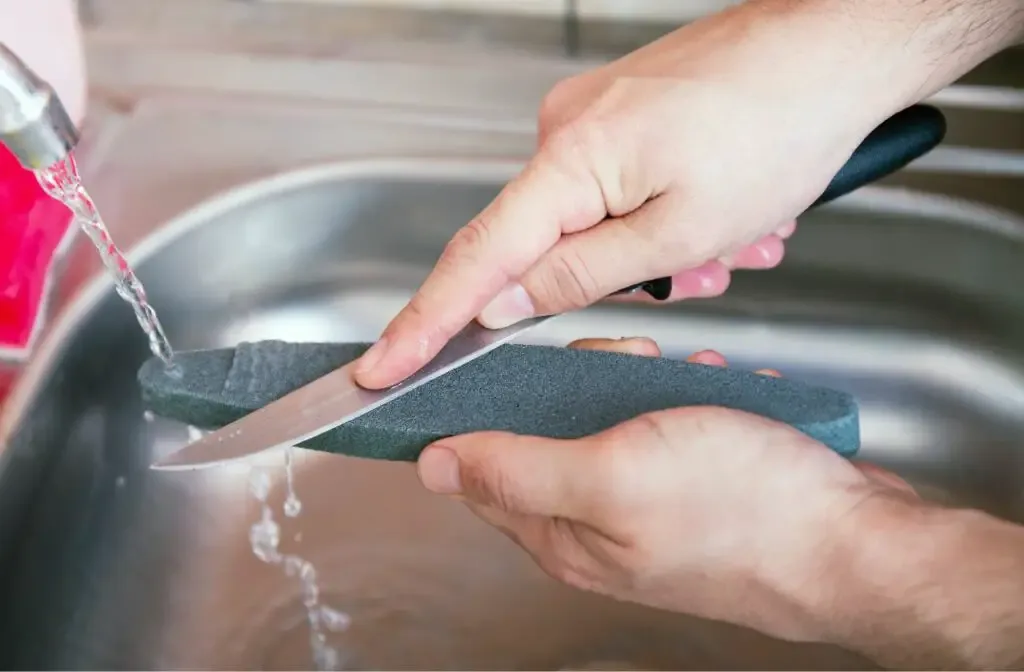
Soaking of whetstones prior to sharpening depends on the type of whetstone being used. With some stones, it may be a requirement for the proper use of the stone, while on other stones, it may not be necessary at all.
- Diamond stones. These stones do not require soaking before use.
- Waterstones. Some water stones require soaking prior to use, but others do not. Generally, coarse stones benefit from soaking more than fine grit stones. Check the manufacturer’s instructions to establish the requirements for your stone.
- Oil stones. Oil stones use oil rather than water, so they should never be soaked in water. They also do not require soaking in oil prior to use. Simply spread some honing oil on the surface of the stone when you start sharpening, and replenish the oil as required.
- Ceramic stones. Some ceramic stones, such as coarse grit stones, can benefit from soaking in water for 10 to 15 minutes before use. However, this is not always necessary, so follow the manufacturer’s instructions for the stone. High-grit ceramic stones do not usually require soaking.
What Happens If You Use A Whetstone Dry?
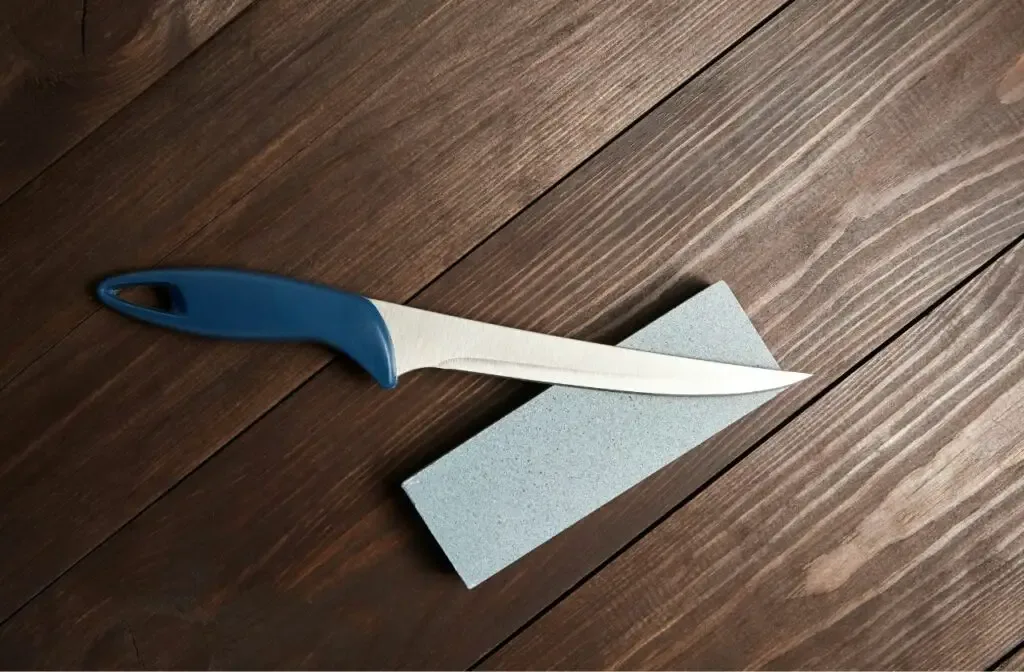
Some whetstones can be used dry in a pinch, but most whetstones will show an improvement in performance if a lubricant is used with the stone.
Using a whetstone dry, without any lubricant, increases the wear on the stone and shortens the life of the stone. A lubricant allows the knife edge to glide over the stone and only makes contact with the peaks of the abrasive.
Using the stone dry allows the knife to dig deeper into the stone and dislodge abrasive material, wearing the stone down faster.
Lubricants also wash the waste material array from the abrasive surface, effectively keeping the stone cutting effectively and efficiently. This improves the speed with which a knife can be sharpened and limits the wear inflicted on the stone.
TIP: Are you looking to buy a new whetstone? Check out our recommendations (we personally use the first three ones):
Our PRO choice whetstones combo (Amazon links):
- Fixing stone: Whetstone SHAPTON Ceramic KUROMAKU #320
- Sharpening stone: Suehiro CERAX soaking whetstone: Medium #1000
- Finishing stone: Whetstone SHAPTON Ceramic KUROMAKU #5000
Our budget choice (Amazon link): Sharp Pebble Extra Large Sharpening Stone Set
Whetstones FAQ
Q: Why is it essential to maintain a whetstone?
A: Proper maintenance of a whetstone ensures its longevity and effectiveness. Neglecting its upkeep can reduce its sharpening ability and in some cases, even ruin the stone.
Q: How often should I clean my whetstone?
A: It’s recommended to clean your whetstone after each use. This prevents the build-up of sharpening waste and ensures the stone remains effective for future sharpening sessions.
Q: Can I use any oil on an oil sharpening stone?
A: No, not all oils are suitable for oil sharpening stones. Avoid vegetable oils as they can become rancid and degrade over time. It’s best to use oils specifically formulated for sharpening stones.
Q: Is it necessary to soak a whetstone before use?
A: This depends on the type of whetstone. Some water stones require soaking, while diamond and ceramic stones typically do not. Always refer to the manufacturer’s instructions.
Q: What happens if I use a whetstone dry?
A: Using a whetstone dry can increase wear on the stone, shortening its lifespan. Lubricants, whether water or oil, improve the sharpening process and reduce wear on the stone.
Q: How do I know when my whetstone is worn out?
A: If your whetstone becomes too thin, uneven, or the sharpening process becomes notably less effective, it might be time to replace it.
Q: Can I use both sides of a whetstone for sharpening?
A: Yes, if both sides are designed for sharpening. Flipping and using both sides can ensure even wear and prolong the stone’s life.
Q: How do I store my whetstone after use?
A: After cleaning, ensure your whetstone is dry before storing it. This prevents mould growth and potential damage from freezing if the water inside the stone turns to ice.
Q: Are expensive whetstones always better than cheaper ones?
A: Not necessarily. The effectiveness of a whetstone depends on its grit, material, and how it’s used. However, higher-quality stones often provide better results and last longer.
Q: What’s the difference between a water stone and an oil stone?
A: The primary difference lies in the lubricant used. Water stones use water, while oil stones use oil. Once you choose a lubricant for a stone, it’s essential to stick with it for the stone’s lifespan.
Conclusion
Whetstones can last a long time, but lack of maintenance and poor care can significantly shorten the usable life of your sharpening stone.
Considering the substantial investment to acquire some of these stones, it makes sense to put the effort in to get as much use out of your whetstones as possible.
TIP: Knife sharpening is an aspect of knife ownership that is intimidating for beginners, but knife sharpening systems can be useful helpers. Check out the best knife sharpening systems in the article below:
Ultimate Guide: Best Knife Sharpening Systems for Beginners

